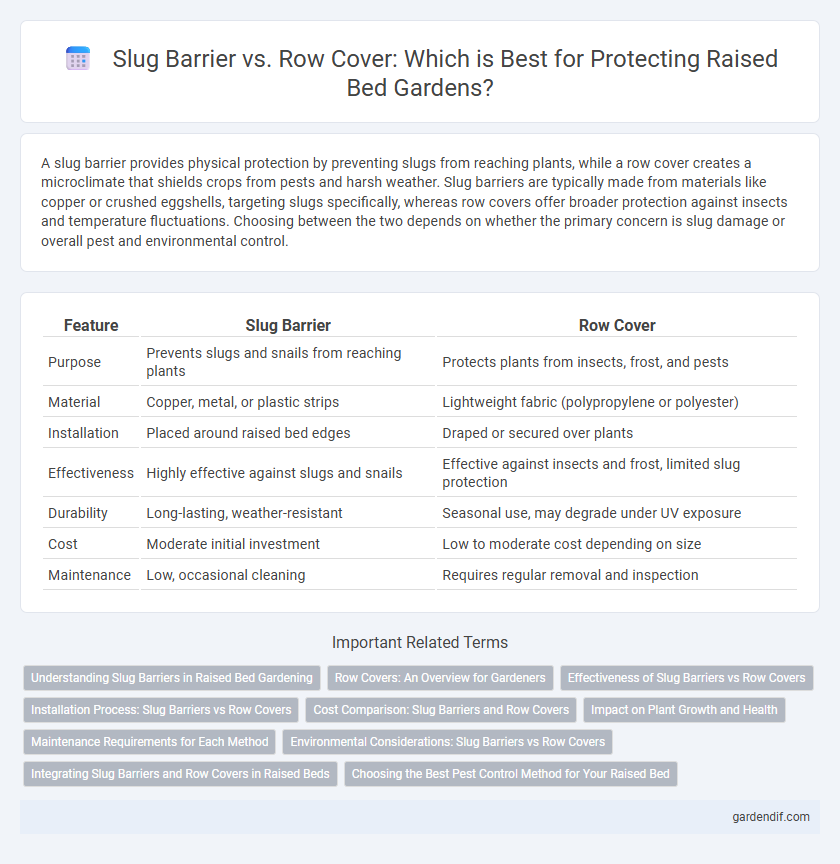
Slug barrier vs Row cover Illustration
A slug barrier provides physical protection by preventing slugs from reaching plants, while a row cover creates a microclimate that shields crops from pests and harsh weather. Slug barriers are typically made from materials like copper or crushed eggshells, targeting slugs specifically, whereas row covers offer broader protection against insects and temperature fluctuations. Choosing between the two depends on whether the primary concern is slug damage or overall pest and environmental control.
Table of Comparison
| Feature | Slug Barrier | Row Cover |
|---|---|---|
| Purpose | Prevents slugs and snails from reaching plants | Protects plants from insects, frost, and pests |
| Material | Copper, metal, or plastic strips | Lightweight fabric (polypropylene or polyester) |
| Installation | Placed around raised bed edges | Draped or secured over plants |
| Effectiveness | Highly effective against slugs and snails | Effective against insects and frost, limited slug protection |
| Durability | Long-lasting, weather-resistant | Seasonal use, may degrade under UV exposure |
| Cost | Moderate initial investment | Low to moderate cost depending on size |
| Maintenance | Low, occasional cleaning | Requires regular removal and inspection |
Understanding Slug Barriers in Raised Bed Gardening
Slug barriers in raised bed gardening create a physical boundary that prevents slugs from reaching plants by using materials such as copper tape, diatomaceous earth, or mesh. These barriers reduce slug damage effectively without harming beneficial insects, making them a sustainable pest control option. Unlike row covers that primarily protect plants from flying insects and environmental elements, slug barriers specifically target ground-dwelling pests and maintain airflow around plants.
Row Covers: An Overview for Gardeners
Row covers provide effective protection against pests such as slugs, insects, and birds by creating a physical barrier that also helps regulate temperature and moisture in raised beds. Made from lightweight, breathable materials like spunbonded polyester or polypropylene, they allow sunlight, air, and water to pass through while shielding plants from damage. Unlike slug barriers that primarily prevent slugs, row covers offer comprehensive garden defense and promote healthy plant growth in various weather conditions.
Effectiveness of Slug Barriers vs Row Covers
Slug barriers provide a physical obstacle that effectively prevents slugs from reaching plants by creating an impenetrable or unpleasant surface, such as copper tape or diatomaceous earth. Row covers offer protection by creating a physical barrier that excludes slugs and other pests while also regulating temperature and humidity, promoting healthier plant growth. While slug barriers target slugs directly through repellency or obstruction, row covers provide broader pest control and environmental benefits, making each method effective depending on specific garden needs.
Installation Process: Slug Barriers vs Row Covers
Installing slug barriers involves burying or securing copper tape or mesh around raised bed edges to create a continuous protective ring against slugs, ensuring no gaps are left for entry. Row covers require draping fabric over lightweight hoops or frames anchored firmly into the soil, providing an effective physical shield against pests while allowing light and moisture penetration. Both methods demand careful sealing along edges, but slug barriers focus on ground-level installation, whereas row covers protect the entire plant canopy.
Cost Comparison: Slug Barriers and Row Covers
Slug barriers generally incur a one-time installation cost ranging from $15 to $50 per bed, offering long-term protection against slug damage with minimal maintenance expenses. Row covers, while initially cheaper at approximately $5 to $20 per square yard, often require seasonal replacement or repair, which can increase overall costs over time. Considering durability and recurring expenses, slug barriers tend to be more cost-effective for prolonged garden protection compared to row covers.
Impact on Plant Growth and Health
Slug barriers effectively protect young plants from slug damage, preventing leaf loss and promoting healthier growth by minimizing pest stress. Row covers enhance plant health by creating a controlled microclimate, improving temperature and humidity levels, which accelerates growth and boosts yield potential. Combining both methods optimizes plant protection and growth, reducing pest impact while enhancing environmental conditions.
Maintenance Requirements for Each Method
Slug barriers require regular inspection and cleaning to remove debris and prevent gaps that slugs can exploit, ensuring their effectiveness in raised beds. Row covers demand daily monitoring to keep them securely fastened and free from tears or holes that allow pests to enter. Both methods involve consistent upkeep, but slug barriers typically need less frequent adjustments compared to the more hands-on maintenance of row covers.
Environmental Considerations: Slug Barriers vs Row Covers
Slug barriers, typically made from materials like copper or diatomaceous earth, offer an environmentally friendly pest control solution by reducing the need for chemical slug pellets and minimizing soil disturbance in raised beds. Row covers, composed of lightweight fabric, provide a physical barrier against a broader range of pests while also enhancing microclimate conditions that promote plant growth but require careful disposal and maintenance to prevent plastic waste. Both methods contribute to sustainable gardening practices, yet slug barriers prioritize soil ecosystem health, whereas row covers emphasize pest exclusion and plant protection.
Integrating Slug Barriers and Row Covers in Raised Beds
Integrating slug barriers and row covers in raised beds enhances pest control by creating a dual physical defense against slugs and other garden pests. Slug barriers, made from copper, mesh, or diatomaceous earth, restrict slug movement at the soil level, while row covers protect plants from airborne insects and temperature fluctuations. Combining these methods supports healthier plant growth and reduces reliance on chemical pesticides in raised bed gardening.
Choosing the Best Pest Control Method for Your Raised Bed
Slug barriers provide a physical deterrent specifically targeting slugs and snails in raised beds, using materials like copper tape or diatomaceous earth to prevent pests from reaching plants. Row covers offer broader pest control by protecting crops from various insects and environmental stressors while allowing light and moisture to penetrate. Selecting between slug barriers and row covers depends on the primary pests in your raised bed and whether you need targeted slug protection or comprehensive insect and environmental defense.
Slug barrier vs Row cover Infographic

 gardendif.com
gardendif.com